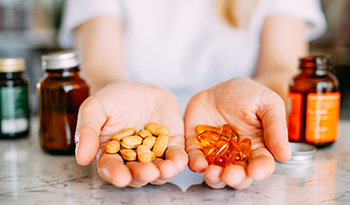4 bedste sunde vaner at praktisere dagligt ifølge en naturopatisk læge

Der er intet som en daglig rutine for at få os til gode vaner. Vaner gør det muligt for os at være mere fokuserede, skabe gode arbejdslivsgrænser, give næring til vores kroppe og nære vores humør. Og når du ikke behøver at tænke over, hvad du vil gøre hver dag, giver det mere mentalt rum til at fokusere på ting, der giver dig glæde.
I dag deler jeg mine top fire sunde vaner for at hjælpe dig med at komme ind i en rille, så du også kan føle dig godt tilpas.
1. Optimer døgnrytme
God søvn er god medicin. Solid forskning viser, at det at få nok søvn kan reducere risikoen for infektionssygdomme og inflammatoriske problemer som hjerte-kar-sygdomme, humørproblemer som depression og endda kronisk sygdom.1
Søvn er en af de bedste og billigste ting, du kan gøre for at leve længere. Så jeg fokuserer på at få det rigtigt!
Nøglen til at hacke søvn og døgnrytme og få dem til at fungere for dig er at forstå, at når du sover, er lige så vigtigt som hvor meget tid du sover hver nat. Vidste du for eksempel, at din krop producerer det meste af sin melatonin mellem kl. 22 og 2 om morgenen? Eller at dette også er det optimale vindue til dyb søvn, hvilket er når dit væv heles og regenererer?
Søvntiming
Melatonin er en vigtig antioxidant. Ikke kun er det forbundet med serotonin og god søvn, men som en antioxidant er melatonin forbundet med levetid, immunfunktion, hormonregulering og mere.
Jeg prioriterer at falde i søvn inden kl. 22, så jeg kan drage fordel af min naturlige døgnrytme og producere den maksimale melatonin mængde, min krop er i stand til hver dag. Jeg har nydt godt af dette i form af mindre betændelse, bedre humør og bedre bedring.
Jeg prøver også at sikre, at jeg sover otte timer om natten og stoler på en søvnmåler for at holde mig ansvarlig.
Søvnsporing
På klinikken siger vi ofte: „Hvis du ikke sporer det, kan du ikke vide det!“ En bærbar sporingsenhed kan rapportere tilbage om de faser af søvn, som din krop gennemgår hver nat og den samlede søvntid. Når du har forstået dine underskud, kan du arbejde sammen med din læge for at finde de bedste behandlinger.
Som en bonus giver bærbare trackere dig og din praktiserende læge også omfattende information om dit helbred, herunder bevægelse, trin, puls, biometri og mere.
Giv energi om morgenen
At gå i seng på et optimalt tidspunkt er starten. At stige med solen er også en god praksis for at hjælpe din krop med at synkronisere sin egen naturlige døgnrytme med planetens. Naturopatiske læger anbefaler ofte at komme udenfor de første 15 minutter af dagen for at tage nogle gode, dybe vejrtrækninger og lade dine øjne se sollyset først om morgenen. Himlens blå lys hjælper med at slukke for søvnhormoner og tænde for energigivende daghormoner, der giver dig energi, kontrollerer betændelse og optimerer hormonproduktionen.
En anden af mine yndlingsrutiner er at tage B-vitaminer om morgenen for deres positive effekt på energien.2
Brug for mere? Tag et dybt dyk ned i flere tip til nulstilling af din søvnplan her.
2. Bliv hydreret
Dit blod leverer ilt og hvert eneste næringsstof, dine celler har brug for til dit væv, hjerne og organer hver dag. Du har sandsynligvis mistanke om, at dit blod er lavet af væske, men vidste du, at det meste af den væske kommer fra det vand og væsker, du drikker?
Vandet i blodet kaldes plasma.3 Plasma er faktisk tættere på koncentrationen af havvand end det er på ledningsvand.4 Hvis du nogensinde har haft en IV, vil du huske, at det generelt er natrium og chlorid. Det indeholder også elektrolytter, vitaminer og næringsstoffer som glukose og aminosyrer.3
Jeg prøver at forbruge væske, der ligner plasma så meget som muligt, så min krop ikke behøver at gøre det hårde arbejde med at stjæle elektrolytter fra mit væv for at skabe afbalanceret væske i mit kardiovaskulære system. Dette betyder indtagelse af vand, der er forblandet med elektrolytter og nogle gange endda protein. Det lønner sig ved at hjælpe mig med at føle mig mere energisk og glad og hjælper med at forbedre min bedring fra træning, så jeg får de største fordele ved træning uden ulemperne.
For at få flere elektrolytter tilføjer jeg spormineraler hver gang jeg fylder min vandflaske. (Sjovt faktum - mineraler og elektrolytter er faktisk den samme ting!)
Fordi jeg sporer mit indtag af mad og næringsstoffer, ved jeg, at jeg kæmper for at indtage nok kalium og magnesium de fleste dage, medmindre jeg tager et kosttilskud. Så jeg har min egen ryg ved at finde lækre måder at inkludere dem i min daglige rutine.
Der er mange nemme måder at få elektrolytterpå. Tal med din praktiserende læge om, hvilke af følgende muligheder der er bedst for dig, og hvor ofte du skal tage dem:
- Flydende elektrolytter: Væsker kan gå lige i din vandflaske. Du kan også rekonstituere mange flydende elektrolytter i en større beholder, så de er klar, når du er.
- Pulvere: Pulverformede former er nemme at bære (til gymnastiksalen!) pinde og pakker såvel som i pengebesparende containere. Du skal blot tilføje til din vandflaske og ryste. Disse er praktiske, når du er på farten.
- Elektrolytpiller: Piller er en fremragende mulighed for dem, der ikke rigtig ønsker at smage deres elektrolyter - selvom de er blevet aromatiseret. Bare sørg for at drikke rigeligt med vand hver gang du tager en pille.
- Brusetabletter: Brusende faner sprudler op, når de falder ned i vand. De kommer i praktiske bærbare pakker og er et andet godt valg, når du er på farten.
Generelt tager mine klienter elektrolytter om morgenen og under træning. Hvis de vælger piller, foreslår jeg, at de tager dem med et måltid. Jeg anbefaler også, at klienter tager elektrolytter, når de føler sig utilpas, især hvis de mister væske gennem opkastning eller diarré, eller hvis de har feber.
Elektrolytter kan være farlige, hvis du har en hjertesygdom eller alvorligt helbredsproblem eller tager visse lægemidler. Tal altid med din læge, før du føjer dem til din rutine.
3. Flyt 30 minutter dagligt
Før du tænker, „Jeg ikke/kan ikke træne,“ læs videre! At bevæge sig 30 minutter om dagen behøver ikke at betyde at gå i gymnastiksalen. At bevæge sig 30 minutter om dagen betyder netop det - at få dig selv i bevægelse og din puls op! Du kan gøre det på en måde, der giver dig glæde og inkluderer masser af musik eller familietid. At blive kreativ er nøglen til at nyde motion, og det er vigtigt, at du gør det. Træning er knyttet til levetid og kan også øge immuniteten.
American Heart Association har fremsat den hjertesunde anbefaling om at træne 150 minutter om ugen i årtier - fordi det virker.5 Dit hjerte leverer blod i hele kroppen. Dette blod transporterer ilt og næringsstoffer til hvert væv i din krop - det betyder dine hårdtarbejdende organer som hjernen, leveren og nyrerne plus din hud, negle og hår.
Du kan se, hvorfor det er vigtigt at komme videre.
Du vil gerne tjekke ind med din læge, før du starter en bevægelsesrutine, især hvis du har eksisterende medicinske tilstande. Hvordan du bevæger dig afhænger af dine specifikke mål. Nogle af mine anbefalinger til mine klienter inkluderer:
- Kardiovaskulær sundhed: For et sundt hjerte skal du øve HIIT (højintensiv intervaltræning), sport, gå, jogge, løbe efter dine børn eller kæledyr eller danse. Disse typer træning passer godt sammen med musik eller venner. Hvis du har børn eller børnebørn, er chancerne store for, at de vil elske at komme ind på at spille sport med dig!
- Fleksibilitet: Vælg yoga eller pilates for at forblive fleksibel. Disse fokuserer på at forlænge og styrke muskler, ledbånd og fascia. Yoga har også et meditativt sind-krop-link, mens Pilates forbedrer kerne- og muskelstyrken.
- Muskel- og knoglestyrke: For muskel- og knoglemasse, lær at vægtløfte - og løft tungt, hvis du kan! Tunge løft har vist sig at opbygge knogler og kan endda vende osteopeni og osteoporose. Der er mange måder, du kan lære at løfte på, og de behøver ikke at være dyre. Køb rundt blandt fitnesscentre i nærheden af dig, og kig efter dem, der tilbyder instruktion, så du lærer den rigtige form. En personlig træner er også en mulighed. Og husk, du har brug for mere protein og mineraler for at støtte dine knogler og stofskifte under vægtløftning.
- Mental Boost: For generelle sundhedsmæssige fordele, med en ekstra dosis glæde, prøv at danse, vandre eller skøjteløb med venner. De fleste af disse aktiviteter er gratis eller billige. Træning behøver ikke at være i gymnastiksalen!
Og husk - nu hvor du ved alt om at tilføje vand til din rutine - bliv hydreret før, under og efter træning.
4. Spor makroer og mikroer
Husk ordsproget, „Hvis du ikke sporer, kan du ikke vide det?“ Det er ikke kun gode råd til søvn - det er også gode råd til, hvad du spiser. Bevidsthed om, hvad du spiser, er vigtig, fordi det afslører de huller, du skal udfylde. Det er især vigtigt at se på dine makroer og mikroer.
Makronæringsstoffer er proteiner, kulhydrater og fedtstoffer og er de grundlæggende byggesten i en god ernæringsplan. At få nok af disse gør det muligt at have god energi, et sundt stofskifte, opbygge muskler og styrke knogler.
Mikronæringsstoffer, som B-vitaminer, vitamin Dog vitaminer A, Cog E, giver os energi, holder huden strålende og giver næring til stofskiftet. Mineraler hjælper med at holde os rolige, kan forbedre vores mentale sundhed og hjælpe os med træningsrestitution.
Du kan spore dit næringsindtag eller arbejde med en praktiserende læge, der kan gøre det for dig for at afsløre, hvilke næringsstoffer du måske har brug for mere af.
Min helbredsvane - jeg sporer hver dag. Og fordi jeg sporer, ved jeg, at selvom min diæt er ret fyldt, har jeg plads til at forbedre mig med mit cholin indtag. Dette giver mening, fordi jeg ikke kan spise æg på grund af en allergi - og æg er en topkilde til cholin. Jeg glemmer også nogle gange mit cholintilskud om natten, og dataene viser mig, at det har konsekvenser for mit helbred, når jeg gør det.
De oplysninger, jeg får fra sporing, hjælper mig med at indse, at jeg er nødt til at komme tilbage på sporet med at tage mit supplement eller skifte det til en anden form eller et andet tidspunkt på dagen, der giver mig mulighed for at være mere konsekvent. Det samme gælder for jern, jod, calciumog kalium, som har en tendens til at være lidt lave i mit daglige indtag.
En strategi, jeg måske bruger, er at holde mit cholintilskud ved siden af mit multivitamin, som er ude på disken for mig at tage efter morgenmaden. Om et par måneder med at være i overensstemmelse med denne ændring, skulle jeg se, at cholintallet kommer til 100%!
Din læge vil arbejde sammen med dig for at finde den bedste tracker, samt hvordan du udfylder hullerne i din ernæringsplan med fødevarer og kosttilskud.
Dette er vigtigt: Spor ikke, om du har en historie med en spiseforstyrrelse, da det kan være udløsende. Arbejd i stedet med en kvalificeret læge for at bestemme, hvilke huller du skal udfylde.
Denne vane virker for mig, men det fungerer måske ikke for dig. Det vigtigste her bør være, at det at være opmærksom på dit helbred kan betale sig ved at afsløre de områder af din diæt, du faktisk har brug for at være opmærksom på. Jeg kan godt lide at praktisere evidensbaseret ernæring snarere end at følge et tilfældigt sæt standarder eller regler.
Hvis du ikke sporer, kan du ikke vide det!
Bundlinjen
At passe på dig selv er job et, især hvis du har andre at passe på, fra små til betydningsfulde andre til forældre. Vi jonglerer alle med mange ting i dette liv, og det er vores førstefødselsret at føle sig godt udhvilet, hydreret, stærk og næret. Det er vores førstefødselsret at have det godt.
Der er gode nyheder: Et par daglige sunde vaner kan gøre hele forskellen. De behøver heller ikke tage lang tid eller koste mange penge. Du kan implementere nogle på egen hånd, som at komme i seng til tiden for god søvn, sikre at du får nok vand og begynde at bevæge din krop. Andre gøres bedst ved hjælp af en kvalificeret praktiserende læge, der kan rådgive om, hvilke makro- og mikroer, træningstyper og kosttilskud der vil gavne dig og din livsstil mest.
Du kan gøre det! For en detaljeret (time for time!) oversigt, tjek mit fulde daglige regime her!
Referencer:
- Irwin, M.R. (2015). Hvorfor søvn er vigtig for helbredet: Et psykoneuroimmunologisk perspektiv. Årlig gennemgang af psykologi, 66 (1), 143—172. https://doi.org/10.1146/annurev-psych-010213-115205
- Hanna, M., Jaqua, E., Nguyen, V. og Clay, J. (2022). B-vitaminer: Funktioner og anvendelser i medicin. Den permanente journal, 26 (2), 89—97. https://doi.org/10.7812/TPP/21.204
- Hvad gør blod? (2019, 29. august). NIH.gov; Institut for Kvalitet og Effektivitet i Sundhedspleje (IQWiG). https://www.ncbi.nlm.nih.gov/books/NBK279392/
- Hæmatologisk ordliste. (2021). Hæmatologi.org. https://www.hematology.org/education/patients/blood-basics
- American Heart Association anbefalinger til fysisk aktivitet hos voksne og børn. https://www.heart.org/en/healthy-living/fitness/fitness-basics/aha-recs-for-physical-activity-in-adults
ANSVARSFRASKRIVELSE: Wellness Hub har ikke til hensigt at stille diagnoser...














































































 Indholdsfortegnelse
Indholdsfortegnelse














